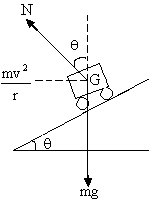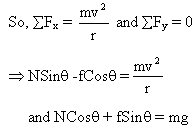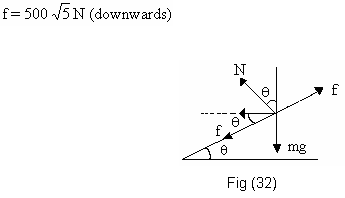study material-physics-mechanics-work power energy
Work Power Energy -6
Banking of Roads:
When vehicle go through turnings, they travel along a nearly circular arc. There must be some force to produce the required centripetal acceleration. Centripetal force is provided to the vehicle by following three ways.
- By friction only
- By banking of roads only
- By friction and banking of roads both.
1) By friction:
Let a car of mass m is moving at a speed v is at horizontal circular arc of radius r.
![]()
And fL= limiting value of f = ![]() N =
N = ![]() mg (N=mg)
mg (N=mg)
For a safe turn without sliding,

So if m and r is fixed the speed of the vehicle should not exceed ![]() and if v and r is fixed then coefficient of friction should be greater than
and if v and r is fixed then coefficient of friction should be greater than ![]()
2) By banking of roads only:
To avoid friction outer part of road is some what lifted compared to the inner part.

Fig (29)
From figure (29) NSin![]() =
= ![]() and NCos
and NCos![]() = mg
= mg
From this we get, Tan![]() =
= ![]()
![]()
At two speeds car does not slide down even if track is smooth.
3) By friction and banking of road both:
If a vehicle is moving on a circular road which is rough and banked also then magnitude of N and direction plus magnitude of friction mainly depends on the speed of the vehicle V-
- f is outward if v = 0
- f is inward if v>

- f is outward if v <

- f is zero if v =

a) When the car is at rest f is upward-


Fig (30)
b) Now when the car is given a small speed v, ------- equation (1) becomes
![]()
Illustration:
A turn of radius 20m is banked for the vehicle of mass 200kg going at a speed of 10m/s. Find the direction and magnitude of frictional force acting on a vehicle if it moves with a speed a) 5 m/s b) 15 m/s assume the friction is sufficient to prevent slipping ( g = 10m/s2).
Solution:
a) The turn is banked for speed v = 10 m/s therefore ![]()
As the speed is decreased force of friction f acts upwards


Fig (31)

Substituting![]() , v=5 m/s, m=200kg, r=20m
, v=5 m/s, m=200kg, r=20m
![]()
b) Here force of friction f will act downwards

Substituting v=15 m/s,![]() , m=200kg and r=20m we get
, m=200kg and r=20m we get
